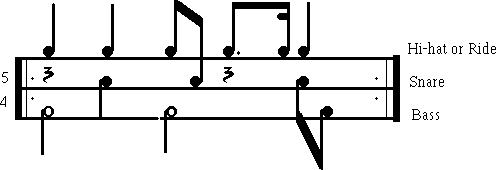


Classic Jazz or Swing 5/4:
If you have mastered the Jazz Waltz beat in the previous lesson,
this will be easy. 5/4 is a very uncommon time . . . based on five quarter notes to the bar, it has a somewhat lop-sided
and uncomfortable feel.
The Permutation and Time Signature lessons in Finite to Infinity have taught us that there are at least 1,099,511,627,776 potential variations of 5/4. With that in mind, it is interesting to note that this one single version, (the 'Swing' or 'jazz' version) is by far the most notable of all trillion+ (other variation) possibilities. To my thinking, it seems about time for an innovative song writer and composer to utilize one or two of the other trillion+ permutations. (See "Finite to Infinity" for clues on how to do that. I'll also offer another clue at the bottom of this lesson.)
After studying it here, it may be helpful to locate and listen to a song based on this rhythm. One specific great old jazz tune comes to mind. Look for a song called 'Take Five' by Dave Brubeck. I think this song has hit the charts two separate times. Do a web search for an old album entitled 'Time Out', by Dave Brubeck. The song 'Take Five' was the hit song off that album. The original version featured Joe Morrelo on drums.

FILLS:
It may be best to begin all your fills on the first
count of the measure. If you play 5 groups of most fills . . . you will come
out on the first count of the next measure. Later on, you may want to experiment
with fills that begin on the 2nd, 3rd, 4th or even the 5th count of the measure. Again,
the only thing that really matters is that you maintain the five count flow in every bar.
If you lose track in the middle of a song, the entire band will come apart like a house of cards.
It can get downright ugly! Be careful!
Video: For almost all handheld devices and other browsers.
NOTE: It is possible and fairly easy to solo within this odd-time framework.
If we understand the (sometimes weird) math that exists
within time-signature theory, we conclude that it is possible to easily convert 5/4 time to 10/4 time. Doing so brings the 'feel' of all the rhythms
back to an even count, (if desired). We can then slip into a form of 10/4 that for all intentional purposes could be written in 2/4, which is a natural
and normal (or even) count. The bulk of our solo can then be played as we play most of our solos. We would slip back into the 5-count
feel as we resume playing the song. The transitions from 5/4 to 10/4 (then reverting to 2/4 and back) is a smooth and unnoticeable
transition. Most 'ears' may believe you have stayed in 5/4 the entire time because it becomes an arbitrary and/or debatable point.
Can you imagine (and play) an 8th (rock) version of 5/4? What about 8th triplet 'Blues' 5/4? 16th 5/4? See "Finite to Infinity'" to understand it all. It is simpler than you could ever imagine!
THINK TANK! Imagine an 8th-note (rock) form of 10/4, sub-divided into two repetitious bars of 8th 5/4. The bass guitar plays five sets of 2/4 (which is even) while the drummer stays in an 8th-note 5-count (odd). The melody line could be in 5-count or 2-count. Add lyrics that fit. Would it be one of the most unique songs ever written . . . or would it resemble a train-wreck?
Other rhythm instruments (keys) could accent the 5-count feel while still others (horns or whatever) follow the bass-rhythm which is an even 2-count. Do it and please send me a copy. This idea has haunted me for years but I've never been involved with a band that could understand and do it. It's yours now. Take it!
![]()
![]()

![]()
Musical Time - Finite to Infinity:
Finite to Infinity:
Learn to easily jam and play music comfortably within any odd or even time signature. This material isn't currently taught in music-theory classes, yet it is simple enough for grade-school students. Discover more than 18 quintillion unique and different (modern music) song-beat structures.Discover the (lost) 500 year-old enigmatic secrets hidden within the current time-signature system. Seven short mesmerizing and easy-to-follow lessons will lead you quickly and easily towards (musical-time) guru status. You will learn to visualize (read, write or feel) the existence This should lead directly to the e-book.

This very informative little booklet will amaze you with hundreds of valuable tips and insider secrets! HOW TO: Purchase old/used drumsets for pennies and resell them for decent profits.